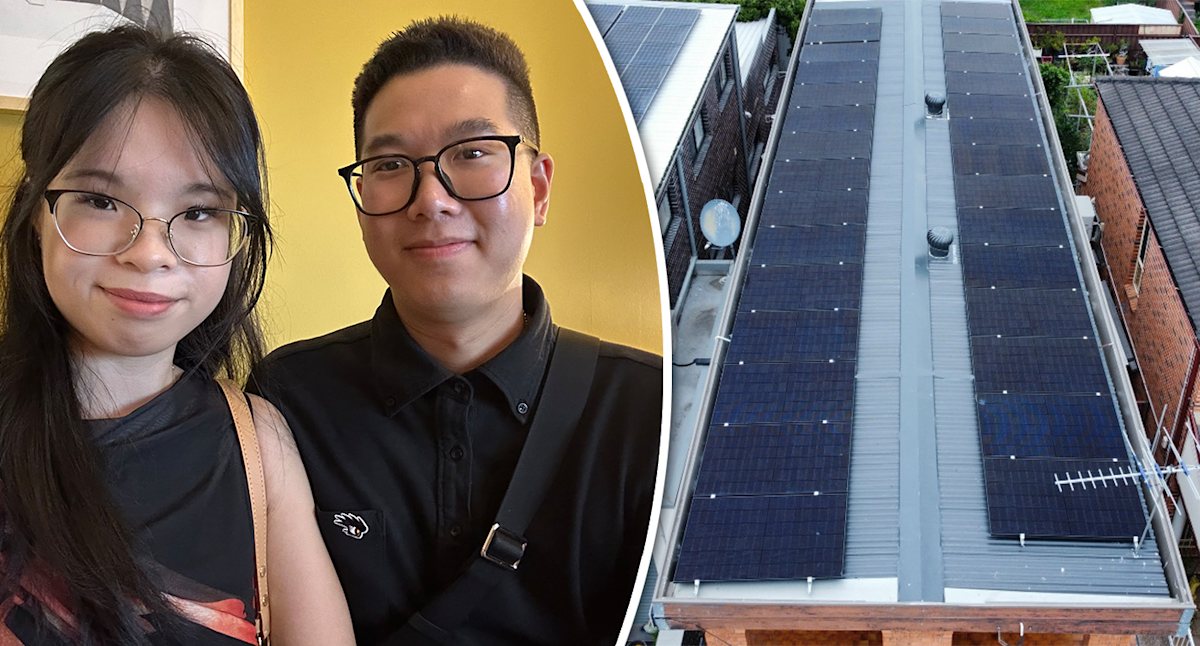Harrison Nguyen and his partner Sheila installed rooftop solar on their Sydney home last year. (Source: Supplied)
Australian households looking to install solar batteries are being warned the federal government’s discount will decrease from January 1 next year. About 100,000 households have already installed solar batteries since the scheme launched four months ago.
Harrison Nguyen recently used the federal rebate to install a second battery at his Sydney home. The 26-year-old IT worker told Yahoo Finance his family no longer wanted to be solely reliant on the grid, or “feel guilty” about using the air-con during summer.
“Before going to solar and battery, we were paying around $400 to $600 a quarter. Now, with the solar and battery combined, we’re virtually paying nothing now,” he said.
RELATED
Nguyen spent around $3,300 installing a 6.6kW solar system and around $6,000 installing a 10.1kW battery in September last year.
With one battery, the family was able to get their electricity bill down to around $50 a quarter. With the second battery, Nguyen expects his bill will now be “zero” or “in credit”.
Ngugen paid about $2,140 for the second battery, which is the same size as the first. That price included the government’s battery discount, plus a promotion his battery installer was running.
Do you have a story to share? Contact tamika.seeto@yahooinc.com
Nguyen said installing solar and batteries has helped him drastically cut his electricity bills. (Source: Supplied)
The government’s Cheaper Home Batteries program launched on July 1 and gives households and small businesses a discount on the upfront cost of installing a battery. The discount is currently around 30 per cent, but will gradually decrease until 2030.
The government revealed 2 gigawatt-hours of storage had now been installed across Australia, with the program increasing home battery capacity by more than 50 per cent.
Nguyen has estimated it will take around six years to payback the cost of the solar system and batteries.
He lives with his partner, Sheila, along with his parents and a sibling, and noted they were now using their electricity more.
It comes after Cotality research revealed homes with solar power systems are valued around 2.7 per cent, or $23,100, more than those without.
Federal solar and battery rebates will step down on January 1.
The discounts operate under the Small-scale Renewable Energy Scheme (SRES) and are based on Small-scale Technology Certificates (STCs).
The value of the STCs are offered as an upfront discount on the cost of a system or battery by accredited installers and retailers. Households don’t apply for the discount and it’s technically not a ‘rebate’.
Story Continues
The solar battery discount is based on the solar battery’s usable capacity and will gradually decrease until 2030. In 2025, the discount rate is 9.3 STCs per kWh, which the government said was equivalent to around $372 per kWh.
In 2026, that will drop to 8.4 STCs per kWh, equivalent to a discount of $336 per kWh. By 2030, it will be 4.7 STCs per kWh, or $188 per kWh.
VoltX COO David Sedighi · Source: Supplied
David Sedighi, chief operating officer of battery provider VoltX, told Yahoo Finance this was part of a planned phase-down as battery prices continue to fall and to encourage uptake at an early date.
“The Australian government home batteries program is designed to step down each year until it completely ends in 2030,” he said.
“From January 1, 2026, both the solar and home battery rebates will reduce again, which means households will receive a smaller discount compared to installations that are completed within 2025.”
The solar panel discount similarly reduces on January 1 each year, until it reaches zero in 2031.
Sedighi said the discount reduction from January 1 would depend on the system size in question.
“In 2026, each usable kilowatt hour will attract 0.9 fewer SCTs,” he said
“The reduction is quite significant as it does affect the end price for a consumer.”
SolarQuotes gave the example of a 13 kWh battery, which is entitled to 120 STCs currently and a discount of around $4,440 after fees, which can vary. From January 1, that same battery will be entitled to 109 STCs, or a discount of around $4,033, around $407 less.
A 10kW solar panel system would currently be entitled to 82 STCs and a discount of around $2,952. But from January 1, it would only be entitled to 69 STCs, or a discount of $2,484 or around $468 less.
Together, that’s around $875 less across a solar system and battery.
SolarQuotes has a solar STC calculator and a federal battery rebate calculator you can use to get an idea of discounts.
Sedighi said the reduction in discounts meant he was seeing more households looking to install before the end of the year.
“The demand has been incredible since the rebate launched in July … And so we project 60,000 homes will have the battery installed in the coming year,” he said.
Sedighi warned households to only use installers who were properly accredited and qualified.
“People need to ensure their installer is properly accredited and qualified. There’s an industry-wide shortage and people need to be very careful to go with a reputable company,” he said.
Sedighi said the cost of a battery was already significantly high and the rebate, even after January, would still provide a significant reduction in the overall cost.
“There is still a case of a benefit for the consumer to take on a battery, even after January. But there’s no doubt the cost-benefit is much bigger today,” he said.
Get the latest Yahoo Finance news – follow us on Facebook, LinkedIn and Instagram.

